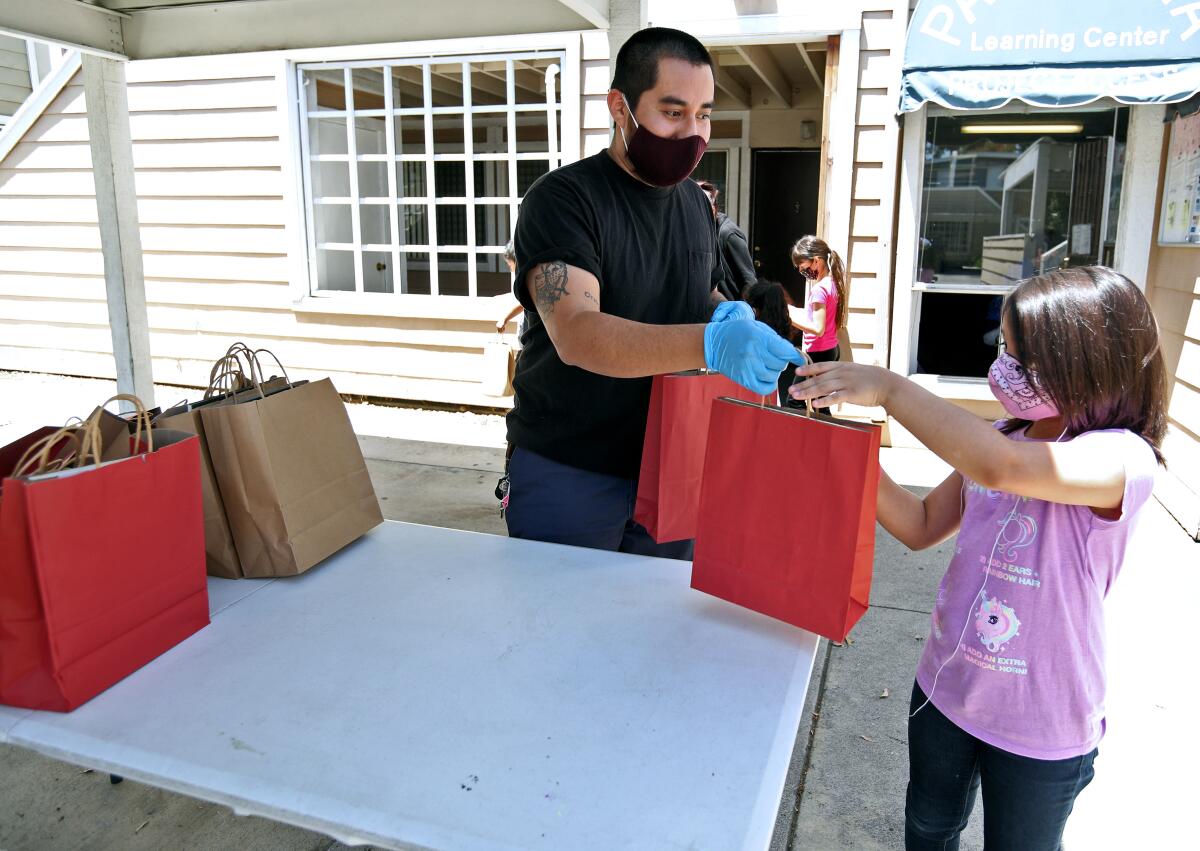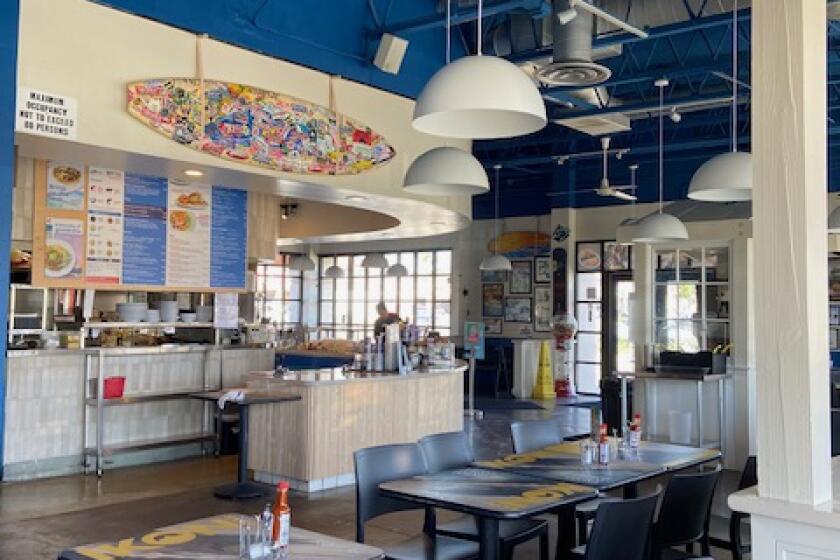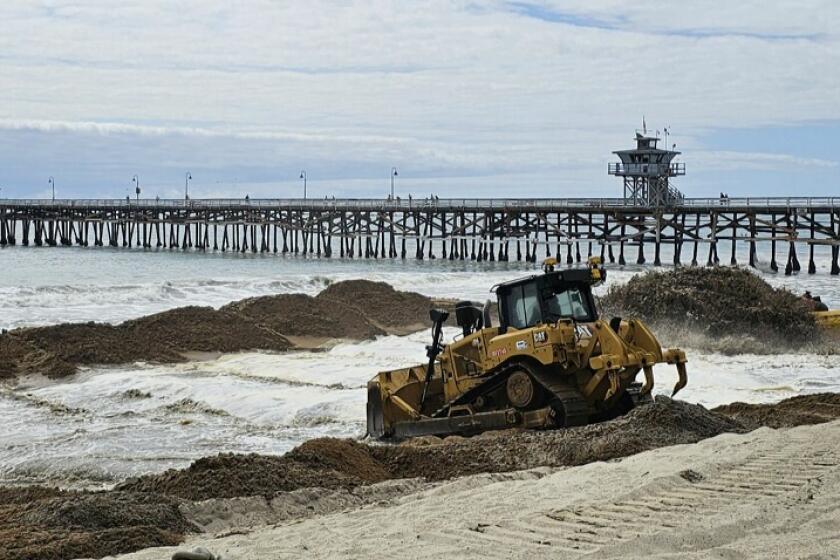How Anaheim artist William Camargo plays with the city’s history and present realities
To see William Camargo’s photography is to take a street-level tour of Anaheim’s past and present.
In one photo, Camargo stands in front of the Anaheim Packing House holding a sign reading “Brown women used to pack oranges here.” The Sunkist warehouse was one of the last remaining packing houses in Orange County. Now, it’s redeveloped as an upscale food hall.
Although the building itself is categorized as a historical landmark, there is little information readily available about the inner lives of workers who picked, cleaned, packed and shipped the fruit.
“People of color get invalidated sometimes,” Camargo said. “A lot of that work that I was doing was looking at history and trying to bring up this memory of the folks that were invisible during that time too.”
The photo belongs in Camargo’s MFA thesis exhibit that was postponed after Claremont Graduate University pivoted to online learning and shut down its on-campus gallery in response to the state’s shelter-at-home order. His show “Origins & Displacements: On Making Sense of Place, Histories & Possibilities” would have examined Anaheim’s history of racism and an imagined future through archived material, performance, portraits and landscape photography.
Camargo and five other recent grads will have a chance to spend time in the school’s studios and show their work when it’s safe to reopen.
David Pagel, a Los Angeles Times contributing art critic and the university’s art department chair, said since the closure, some students were rightfully stunned and lost. Other students’ work intensified and became more focused — primarily those who use cameras.
In Camargo’s case, he began documenting his home life, which happened to be composed of his parents, a pair of essential workers. His mother is a grocery store worker in Northgate Market, and his father works in an assisted living facility as a janitor. He’s captured intimate shared moments both candid and in portrait.
“The whole concept of the work that I’ve been doing here at home is just making do with what I have,” Camargo said. “The other aspect is more sculptural performance.”
He also created the series “As Much As I Can Carry” during the pandemic for one of his last graduate classes, in which he surrounded himself with significant objects from his parents’ backyard.
“It turned into identity-based work,” Camargo said. “The items that I carry are very much symbolic and [contain] cultural references like the chair made in Mexico, the mop which comes from my dad’s janitorial work to the Nike Cortez I’m wearing.”
For him, dealing with the pandemic means creating art with what’s immediately on hand — or in other words, rasquachismo, a Chicano art tradition. It’s not an unfamiliar aesthetic in Camargo’s work. But in a time when a health crisis has brought existing racial and economic marginalization to the forefront, the art tradition’s survivalist type of inventiveness resonates even more.
“William is brilliant as an artist and I say that because he lives in different worlds fully and deeply,” Pagel said. “He manages to move from one world to the other, capturing the best of each and making everyone see more than they would if they only lived in one world.”
He lists academia, art, his Anaheim home life, activism and teaching as the worlds Camargo lives in.
“You can make great work that’s just politically incisive,” Pagel said “You could make great work that’s just beautiful. You can make great work that’s just funny. And he manages to make work that does all of those things.”
In addition to living in Anaheim, Camargo serves as a commissioner of heritage and culture for the city. They’re in the middle of picking a poet laureate. He is also a teaching artist fellow at the Armory Center for the Arts and plans on teaching in community colleges — where he honed in on his artistic perspective.
No stranger to community organizing, he recently partnered with Project Access, a health, education and employment provider for those living in affordable housing. Camargo received an artist teaching grant from Photoville. He used some of the funds to pay bills, and the rest went toward purchasing art supplies for kids in the neighborhood.
Project Access has centers across the country, but four are located in Anaheim alone. They’ve created pick-up meals for the residents. Last month some kids also picked up Camargo’s art supply kits.

At the moment, Camargo is coming face to face with the civil rights unrest in a locked-down world on the verge of reopening. He marched to support the call to end police violence against Black lives in Anaheim’s protests early last week.
“The police don’t have a great record in Anaheim,” he said. “I think that was a reason we showed up and stood in solidarity with George Floyd — cause we’ve been there. We’ve seen the anger in Anaheim for many years even before 2012 happened.”
Although he was living and working as a photojournalist in Chicago at the time, he closely watched the 2012 uprising in response to the killings of Manuel Angel Diaz and Joel Acevedo at the hands of local police. Diaz and Acevedo were the fifth and sixth shootings by officers that year out of nine in total. The events left the community with promises of improvement in police relationship to the community and funding investment for the working-class youth from politicians, but Camargo questions how much improvement is possible with a policing system he says is inherently racist.
For recent protests, he’s opted to leave the camera behind, concerned with protesters’ privacy and the use of facial recognition technology that could lead to arrests. Nevertheless, Camargo takes on a responsibility to show the city he grew up referring to as Anacrime beyond Disneyland.
And he’s embedded in the city in more ways than one.
All the latest on Orange County from Orange County.
Get our free TimesOC newsletter.
You may occasionally receive promotional content from the Daily Pilot.




